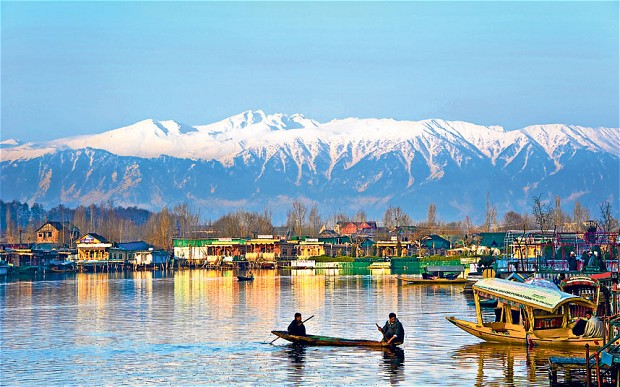Kashmir Youth Fight – to Save the Environment
Under threat -- from a host of factors
SRINAGAR (IPS): Now that the armed conflict between Indian security forces and Kashmiri militants has eased considerably, youngsters are coming out to fight a new threat – environmental degradation – that looms over this beautiful valley often termed ‘paradise on earth’.
Using the bigger space for community participation given the better security situation, young people in the Indian-controlled part of Kashmir have been busy organising festivals and creative campaigns to drum up awareness of environmental woes.
Among their causes are the impacts of climate change that are already being felt by Kashmir’s 9 million people. Climate change concerns are key to this Himalayan region, which has an elevation of more than 1,600 metres and whose key water resources flow from glaciers.
“Over the last three to four decades, Kashmir has witnessed huge environmental degradation. While forest cover has been reduced to a large extent due to deforestation, water bodies have shrunk due to encroachments,” said 26-year-old Owais Rahim of the Kashmir chapter of the Indian Youth Climate Network (IYCN).
“Kashmir’s world-famous Dal Lake is at the verge of extinction because of the irresponsible attitudes of the people and the government. The rest of the lakes like Wullar, Mansbal and Anchar would meet the same fate if right steps are not taken immediately,” added 30-year-old Shahid Ahmad.
Seeing this activism among college and university students, Kashmir University researcher Anzar Khuru said: “The climate negotiations in Copenhagen last year might have failed to churn out commitments from the developed nations to help developing countries cope up with the impacts of climate change, but they have certainly succeeded in bringing the environment under sharp focus.
The young generation, in particular, has now started understanding how a damaged environment influences climatic conditions,” he added. Indeed, young activists’ interest in the environment is a far cry from worrying about violence related to the armed rebellion against India that started in 1989, which also led to separatist movements. But in the past two years, street protests and stone pelting have gradually replaced armed struggle against Indian rule in Kashmir state, a territory also claimed by Pakistan.
Mountainous regions like Kashmir are more susceptible to climate change as it affects every aspect of their environmental, social and economic systems, confirms Shakil Ahmad Romshoo, a climate change researcher at Kashmir University. “The Kashmir valley has been witnessing erratic snowfall, and hot summers have now become a norm in the otherwise cold Kashmir valley,” he said.
“The Kolhai glacier, which feeds the lifeline of Kashmir, River Jhelum, has reduced down to 11.4 square kilometres, from 13 square kilometres, meaning it has shrunk by 18 percent,” Romshoo told IPS.
Activists like Retu Asrani, 25, opine that while big industrial nations have shouldered the blame for emitting greenhouse gases that speed up global warming, developing countries like India must also be blamed for their inadequate protection of the environment.
At the same time, climate change is not just about melting glaciers and water problems. It is linked to everyday issues like food supply as well as the need to reduce pollution, which the young activists are focusing upon as well.
Climate change researchers say food production in Kashmir will also be adversely affected by the faster melting of glaciers, which supply water to the agricultural fields, and frequent droughts caused by global warming.
Green activists also say there are plans for more environmental programmes, including those that use singing, dancing, short films and musical plays to attract the attention of locals.
“Though we have just begun, our (environment awareness) campaign is evoking great response from the youth, especially the student community, and has reached around 27 colleges and all the universities across the state,” explained 22-year-old Zaffar Iqbal. Another cause for concern is pollution, which comes mostly from vehicle exhaust, the burning of fossil fuels in smaller industrial units, and the mismanagement of solid and liquid waste. The lack of a proper public transport system has been driving up car sales, resulting in more emission of harmful gases into the atmosphere. While Kashmir has more than 150,000 vehicles, “more than 55 percent of Kashmir’s vehicles do not conform to pollution norms set by the board,” said Mian Javeed, director of Kashmir’s Pollution Control Board. “Adulterated fuel – kerosene mixed in with diesel for higher profit – also results in more black carbon being pushed into the atmosphere.”
The anti-pollution board has recommended action against the use of illegal brick kilns and stone crushers, used by Kashmir’s burgeoning construction industry. “In a recent survey, we found that only 59 brick kilns, out of a total of 374, were authorised by us. Similarly, only 83 out of the total 204 stone- crushers surveyed had permission from us,” added Javeed.
While the first steps have been taken, there is still a long way to go to spreading environmental awareness in Kashmir, says Sana Mugloo, a business student. “Because of the lack of initiative from the government, we have the worst waste management and sewage treatment system. Environment safeguards are not strictly implemented by the government,” she added.
(INTER PRESS SERVICE)





